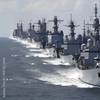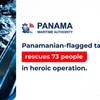Maritime Response Services & Non-Tank Vessel Response Plans
Avoiding Potential Pitfalls and Headaches
The summer of Sub M may be over, but the heat remains for the tugboat and towing vessel industry operating under the July 20th regulations. Owner & Operators are faced with daily challenges to continually sustain and build their businesses. As with any new regulation, there is a period of learn-ing and, even more so, interpretation by industry and by those enforcing regulations. One of the more significant matters related to this situation revolves around vessels in response services and those required to hold Non-Tank Vessel Response Plans (NT-VRP). Navigating through these regula-tions can be complicated, but this article will help identify how to avoid those potential pitfalls and headaches.
It is important to start with some basic background on why tugboats and towing vessels have been required to maintain certified Non-Tank Vessel Response Plan (NT-VRP) prior to Subchapter M. The heart of the issue is found simply in the CFRs (Code of Federal Regulation). Subchapter M is part of 46 CFR, which refers to Shipping. 46 CFR is focused primarily on safety of a vessel through inspec-tions, training and equipment standards. Whereas, response and spill mitigation requirements are found in 33 CFR which refers to Navigation and Navigable Waters, including pollution prevention. Each section of CFR identifies those vessels, individuals or sectors of industry that must comply with the regulation.
There are four areas that Owners & Operators should currently evaluate within their own operation that may involve a potential operator oversight or conflict between their Subchapter M Certificate of Inspection (COI) and what may have previously worked in their response services or NT-VRP approval (33 CFR 155, Subpart J) process.
Those potential conflicts may include:
1. Geographic Limitations
2. International vs. Domestic Tonnage Requirements
3. Total Number of Manning (for Certain Response Services)
4. Conditions of Operation & Restrictions
Let’s examine those four areas a bit closer.
1.Geographic Limitations:
Owners and operators must understand that vessels must comply with permitted routes that their COI authorizes them to operate on. Geographic limitations to operating areas and restrictions on operating conditions may now be different than the vessel’s capabilities at the time the NT-VRP was approved. Currently, the United States Coast Guard will not be providing any additional grace periods for operators to comply with this Subchapter M re-quirement.
The COI permitted routes does not restrict the vessel to a Geographic Specific Area (GSA), but rather is classified by the restricted distance from land that a vessel may operate. Terms such as Inland, Great Lakes, Lakes, Bays, Sounds & Rivers, Limited Coastwise beyond 3 nauti-cal miles, Coastwise not to exceed 20 nautical miles and Oceans are placed on the vessel’s COI to distinguish this permitted operating distance.
It is important to know that the COI identifies permitted routes based off the operating dis-tance from land, not through specific Captain of the Port (COTP) zones or GSA. Due to this measurement process, it still allows operators to navigate lengthy voyages. If a vessel’s COI states Limited Coastwise beyond 3 nautical miles, the vessel can transit along the east coast to the Gulf of Mexico. However, the vessel must operate within 3nm from land for the entire voyage.
2.International vs. Domestic tonnage requirements (NVIC-01-05)
Prior to Subchapter M, some may not have known that there were two different ways to measure a vessel’s tonnage. The traditional domestic gross registered tonnage (GRT) was typically the only reference to measuring a vessel’s tonnage for many years. However, there is a second means to measurement, referred to as gross tonnage (GT) measurements using the international tonnage certification (ITC) (46 USC 14302 (the Convention measurement system)). ITC has been in place since 2004, but did not require vessels without this meas-urement to get it done. The critical and complicated piece to know is that both are tonnage measurements, however, both have drastically different numerical outcomes. Vessels may have 99 GRT measurement, but a 400 GT (ITC) measurement. USCG NVIC 01-05 was pub-lished nearly 13 years ago to help support and provide guidance on the topic along with the process of identifying the NT-VRP requirements.
Owners and Operators must be aware that this international measurement changes many regulatory compliance areas, specifically in 33 CFR Part 155 for response plans, including Salvage and Fire Fighting operations. Although, ITC has not been hidden to the world, it is important to realize that Subchapter M has opened up this requirement to inspectors, audi-tors and others.
3.Total Number of Manning (for Certain Response Services)
The tugboat and towing vessels industry is beginning to see the first round of COIs be issued across the nation. One of areas noted on the COI that has drawn the most attention is to the manning requirements placed on the vessel.
Vessels operating in salvage and marine firefighting and other emergency services may no-tice that additional manning requirements have been required on their COI. This require-ment is intended to ensure that vessels meet regulatory planning criteria including manning resources to reinforce existing efforts among plan holders and their respective service pro-viders in geographic specific areas where their vessels operate. Additional manning is not uncommon to see on vessels that have specialized non-routine services.
4.Conditions of Operation & Restrictions
The last area for Owners/Operators to evaluate is related to restrictions or special condi-tions to operations for their vessel. The conditions of operation may affect your operating prowess, but also have financial consequences that may need to be planned for to limit busi-ness exposure. The COI may identify special requirements for weather conditions, such as wind strength or sea state severity that may limit or restrict your vessel operations. Other areas may include carriage of equipment and personnel, or requirements specific to associ-ated services such as salvage and marine firefighting or emergency towing.
Each of these four areas identified are meant to be used a guidance for self-evaluation of your cur-rent regulatory standing during the sometimes confusing interpretation period. Additionally, there are other options to provide further support on the subject matter to make sure your operation is running at optimal performance. Events such as Green Apple Spill Response Exercise in the New York City area on September 28, Clean Gulf in New Orleans on November 15, as well as others are great opportunities to evaluate your current response plans and speak with other professionals as-sociated with response efforts. Lastly, remember that you always have a direct route to discuss Sub-chapter M compliance by contacting to your local United States Coast Guard Sector and the OCMI.
The Author
Richard Paine is a licensed mariner, certified TSMS & AWO-RCP Lead Auditor and DPA with over 20 years of maritime and auditing experience ranging from deep sea, tugs & towing, and passenger vessels. He is an alumnus of SUNY Maritime College in both undergraduate and graduate studies. A member of PVA’s Safety & Security Committee, he is currently is the Regional Director, HSSQE for Hornblower’s NYC Ferry & Statue Cruises operations. Richard can be reached at [email protected]














